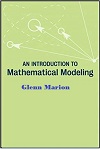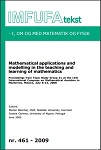An Introduction to Mathematical Modelling by Glenn Marion
MathSchoolinternational contain thousands of
Mathematics Free Books and
Physics Free Books. Which cover almost all topics for students of Mathematics, Physics and Engineering. We have also collected other
Best Free Math Websites for teachers and students.
for teachers and students.
Here is extisive list of
Mathematical Modelling Books . We hope students and teachers like these textbooks, notes and solution manuals.
Share this page:-
We need Your Support, Kindly Share this Web Page with Other Friends

Congratulations, the link is avaliable for free download.
An Introduction to Mathematical Modelling written by
Glenn Marion
Title: An Introduction to Mathematical Modelling
Author(s): Glenn Marion
Publisher:
Series:
Year: 2008
Pages: 35
Type: PDF
Language: English
ISBN:
Download from Amazon :
Join our new updates, alerts:-
For new updates and alerts join our WhatsApp Group and Telegram Group (you can also ask any [pdf] book/notes/solutions manual).
 Join WhatsApp Group
Join WhatsApp Group
 Join Telegram Group
Join Telegram Group
An Introduction to Mathematical Modelling written by
Glenn Marion
cover the following topics.
1. Introduction
1.1 What is mathematical modelling?
1.2 What objectives can modelling achieve?
1.3 Classifications of models
1.4 Stages of modelling
2. Building models
2.1 Getting started
2.2 Systems analysis
2.2.1 Making assumptions
2.2.2 Flow diagrams
2.3 Choosing mathematical equations
2.3.1 Equations from the literature
2.3.2 Analogies from physics
2.3.3 Data exploration
2.4 Solving equations
2.4.1 Analytically
2.4.2 Numerically
3. Studying models
3.1 Dimensionless form
3.2 Asymptotic behaviour
3.3 Sensitivity analysis
3.4 Modelling model output
4. Testing models
4.1 Testing the assumptions
4.2 Model structure
4.3 Prediction of previously unused data
4.3.1 Reasons for prediction errors
4.4 Estimating model parameters
4.5 Comparing two models for the same system
5. Using models
5.1 Predictions with estimates of precision
5.2 Decision support
6. Discussion
6.1 Description of a model
6.2 Deciding when to model and when to stop
A Modelling energy requirements for cattle growth
B Comparing models for cattle growth
List of Figures
1 A schematic description of a spatial model
2 A flow diagram of an Energy Model for Cattle Growth
3 Diffusion of a population in which no births or deaths occur
4 The relationship between logistic growth a population data
5 Numerical estimation of the cosine function
6 Scaling of two logistic equations, dy/dt = ry(a - y) to dimensionless form
7 Graph of dy/dt against y for the logistic curve given by dy/dt = ry(a - y)
8 Plots of dy/dt against y for modified logistic equations
9 Phase plane diagram for the predator-prey system: dx dt = x(1 - y) (prey) & dy dt = -y(1 - x) (predator), showing the states passed through between times t1 (state A) and time t2 (state B)
10 Graph of yi against i for the chaotic difference equation yi+1 = 4yi(1 - yi)
11 Left: The behaviour of the deterministic Lotka-Volterra predator-prey system. Right:
The same model with stochastic birth and death events. The deterministic model
predicts well defined cycles, but these are not stable to even tiny amounts of noise.
The stochastic model predicts extinction of at least one type for large populations. If
regular cycles are observed in reality, this means that some mechanism is missing from
the model, even though the predictions may very well match reality.
12 Comparison of two models via precision of parameter estimates.
13 AIC use in a simple linear regression model. Left: The predictions of the model for 1,2,3
and 4 parameters, along with the real data (open circles) generated from a 4 parameter
model with noise. Right: the AIC values for each number of parameters. The most
parsimonious model is the 2 parameter model, as it has the lowest AIC.
14 Distribution functions F(x) = Probability(outcome¡x) comparing two scenarios A and B.
Note:-
We are not the owner of this book/notes. We provide it which is already avialable on the internet. For any further querries please contact us. We never SUPPORT PIRACY. This copy was provided for students who are financially troubled but want studeing to learn. If You Think This Materials Is Useful, Please get it legally from the PUBLISHERS. Thank you.
?1
?2


